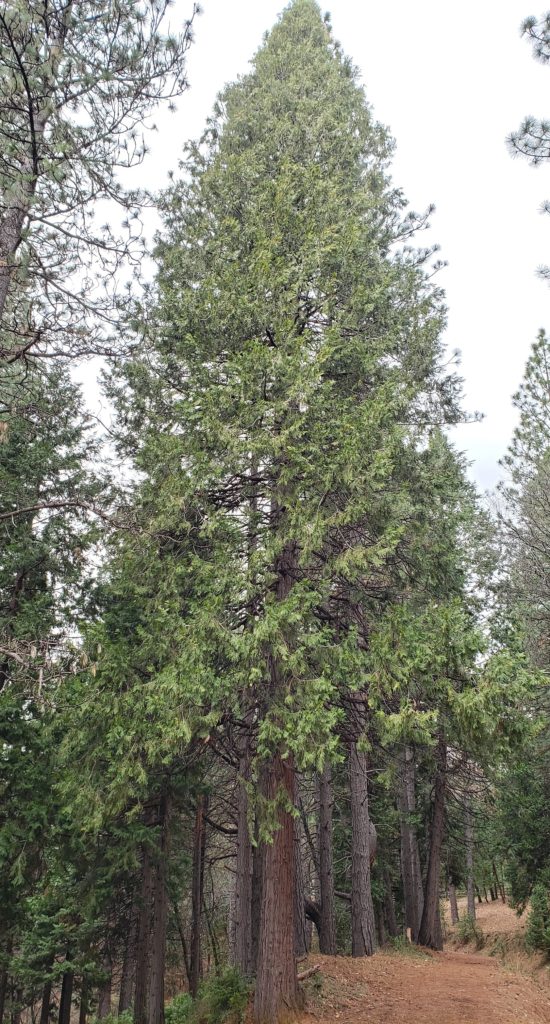I first learned about incense cedar (Calocedrus decurrens) long ago while working with Tree People, a tree planting environmental organization in southern California. One of our missions was to plant smog tolerant trees in the surrounding mountains. Among the list of smog tolerant trees native to the area was the incense cedar. We planted them to replace the smog susceptible trees that were dying off due to the LA smog getting trapped up against the mountains. So I appreciated the incense cedar.
A few years later, while visiting Sequoia National Park, I enjoyed seeing the Giant Sequoias with their tall cone shaped crown and their gigantic trunks with cinnamon colored fibrous bark, and grayish-green, scale-like foliage.
In front of the visitor’s center I spotted two trees, thinking they were both giant sequoias, both with a cone shaped crown, reddish brown fibrous bark, and both very large. But I noticed one had foliage a little greener than the other. So I looked closely and was very surprised to determine that the greener one was an incense cedar! It was so huge that I’d thought it was a giant sequoia! That’s when I fell in love with the incense cedar. I was seeing this tree in its finest glory.
Now I’m happy to live among incense cedars. So I want to point out the benefits of this native tree in our home landscapes, and how to find some fun information on these and other native plant
A true workhorse in our landscapes
Not only is this tree smog tolerant, it’s also drought tolerant, heat tolerant, adaptable to a wide range of soils including poor soil, deer resistant, and virtually pest-free, but it’s also beautiful, keeping a California montane characteristic in our home landscapes. It’s even used as an attractive ornamental tree in other parts of the world, from southern New England to Europe.
This cedar features a cone shaped crown with fragrant foliage, cinnamon brown, thick, fibrous bark, and typically reaches 75-90 ft., and even up to 150ft. tall.
It is very useful in tall screens, stabilizing slopes, as a windscreen, for shade, and in mixed native plantings and hedgerows that can do some good work in supporting wildlife in our ecosystem.
Incense cedar has an extensive fibrous root system enabling it to survive drought. When you plant a new tree, water it for only the first 4-5 years. You want to be sure to train the roots to develop its drought tolerance.
It grows slowly at first because it’s developing that great root system. But after a couple of years you can see 2-3 ft. of growth per year.
It’s thick bark helps protect the tree from fire damage since it evolved in California’s fire ecology. But it gets mixed reviews on its fire risk, so it’s best to keep it away from the house and other structures.
This tree grows in mountainous forests from Oregon all the way down to northern Baja California.

It’s not even a cedar
The only true cedars are from the middle east, the popular and stately Deodar Cedar being one of only three true cedars. From there the common term refers to a variety of plants in the Cypress family. Most “cedars” are junipers, having aromatic wood and foliage. Our incense cedar is in the Cypress family, as are the redwoods, but only a very distant relative of the junipers. Such is the problem with common names, you can’t rely on them for truth.
What’s that black mold on my cedars?
If you have a dense stand of incense cedars on your property you may have a black sooty mold on the trunks, making them look burnt. You probably think it’s due to poor sunlight and air circulation, and you’d be right. But there’s even more going on there.
The sooty mold is able to grow on the bark because of honeydew, the sweet, sticky excrement from scale insects, called incense cedar scale, that are feeding on the cedar tree under the flakey bark. Birds eat these scale insects in the winter when other insects are scarce. So in a way they are good. But if there weren’t enough birds the scale can get out of control and start to harm the foliage and damage the tree. So scales can actually help the birds and the birds help control the scale.
Older and healthy trees that get enough sunlight are able to resist the scales. And if you have a situation like this on your property the trees should be thinned.
You’ve probably noticed an abundant supply of cedar seedlings popping up every year—this is what results from their prolific seeding.
“In its prime the whole tree is thatched with leaves, so that they shed off rain and snow like a roof, making fine mansions for stormbound birds, and mountaineers.” ~John Muir
The homely wildlife this tree supports
The incense cedar does not provide browsing for deer and does provide good refuge for nesting birds. But does it provide food for birds? Especially the insects the birds need to feed their young at nesting time?
We can find out on Calscape.org, a fantastic website maintained by the California Native Plant Society. It provides a ton of information on each California native plant, the wildlife it supports, and even where you can get the plants.
If we go to Calscape.org and look at incense cedar, we can see a map of where the plant lives. And we find five moth and butterfly species that feed on the cedar’s tough foliage, turning that foliage into valuable protein to feed birds and other animals.
When you click on a butterfly you will find a map of the range where it lives. You’ll also find what other plants that butterfly feeds on, if any.
So from this, I found three moths that are in our area. The only one with a common name is the Olive Hairstreak, which happens to be the prettiest.
The others are not so pretty, but they all play a crucial role in maintaining a healthy ecosystem.
In the spring their caterpillars are munching on the cedar foliage turning that tough foliage into rich protein, the perfect food for our native birds to feed their nestlings.
Without enough native caterpillars there would be fewer birds. And with fewer birds those scale insect populations could explode, which could seriously damage more of the incense cedar trees. Just an example of the interconnectedness of the ecosystem around us.
Some timber uses
As with most plants in the cypress family, cedars contain certain oils, resins, and tannins which give them aromatic and rot resistant qualities.
The incense cedar is useful for some woodwork like paneling, fencing, greenhouse benches, and was widely used for making pencils. But now, pencils are mostly made of tropical hardwoods.
Let the cedars stand out
Keeping or adding more incense cedars in our landscapes helps to maintain our ecosystem, supporting very specific moths and butterflies—which are also pollinators.
And they contribute to the natural beauty of our unique spot on this earth.
The incense cedar is a beautiful tree, easy to grow, maintenance-free, and drought tolerant.
Sure those prolific seedlings pose a small maintenance chore, but I like to think of that as a strength the tree has to ensure its place on the earth, to ensure the continuation of the ecosystem it lives in.
If you want to plant some of these, go to your local nursery and ask for them. Most likely, if they don’t have them, they can get them for you.
Or try transplanting those tiny seedlings, but you’ll have to wait a long time.

